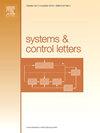Improved residual mode separation for finite-dimensional control of PDEs: Application to the Euler–Bernoulli beam
IF 2.1
3区 计算机科学
Q3 AUTOMATION & CONTROL SYSTEMS
引用次数: 0
Abstract
We consider a simply-supported Euler–Bernoulli beam with viscous and Kelvin–Voigt damping. Our objective is to attenuate the effect of an unknown distributed disturbance using one piezoelectric actuator. We show how to design a state-feedback controller based on a finite number of dominating modes that guarantees that the gain is not greater than a given value. If the remaining (infinitely many) modes are simply ignored, the calculated gain is wrong. This happens because of the spillover phenomenon that occurs when the effect of the control on truncated modes is not accounted for in the feedback design. We propose a simple modification of the cost that prevents spillover. The key idea is to treat the control as a disturbance in the truncated modes and find the corresponding gains using the bounded real lemma. These gains are added to the control weight in the cost for the dominating modes, which prevents spillover. A numerical simulation of an aluminum beam with realistic parameters demonstrates the effectiveness of the proposed method. The presented approach is applicable to other types of PDEs, such as the heat, wave, and Kuramoto–Sivashinsky equations, as well as their semilinear versions. The proposed method gives a Lyapunov functional that can also be used for guaranteed cost control, regional stability analysis, and input-to-state stability.
求助全文
约1分钟内获得全文
求助全文
来源期刊

Systems & Control Letters
工程技术-运筹学与管理科学
CiteScore
4.60
自引率
3.80%
发文量
144
审稿时长
6 months
期刊介绍:
Founded in 1981 by two of the pre-eminent control theorists, Roger Brockett and Jan Willems, Systems & Control Letters is one of the leading journals in the field of control theory. The aim of the journal is to allow dissemination of relatively concise but highly original contributions whose high initial quality enables a relatively rapid review process. All aspects of the fields of systems and control are covered, especially mathematically-oriented and theoretical papers that have a clear relevance to engineering, physical and biological sciences, and even economics. Application-oriented papers with sophisticated and rigorous mathematical elements are also welcome.
 求助内容:
求助内容: 应助结果提醒方式:
应助结果提醒方式:


